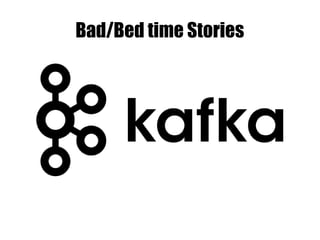kafka
- 2. Today's Menu â Quick Kafka Overview â Kafka Usage At AppsFlyer â AppsFlyer First Cluster â Designing The Next Cluster: Requirements And Changes â Problems With The New Cluster â Changes To The New Cluster â Traffic Boost, Then More Issues â More Solutions â And More Failures â Splitting The Cluster, More Changes And The Current Configuration â Lessons Learned â Testing The Cluster â Collecting Metrics And Alerting
- 3. "A first sign of the beginning of understanding is the wish to die." Franz Kafka
- 4. Quick Kafka
- 5. âAn open source, distributed, partitioned and replicated commit-log based publish- subscribe messaging systemâ Kafka Overview
- 6. Kafka Overview â Topic: Category which messages are published by the message producers â Broker: Kafka server process (usually one per node) â Partitions: Topics are partitioned, each partition is represented by the ordered immutable sequence of messages. Each message in the partition is assigned a unique ID called offset
- 7. Kafka Usage in AppsFlyer
- 8. AppsFlyer First cluster â Traffic: Up to few hundreds millions â Size: 4 M1.xlarge brokers â ~8 Topics â Replication factor 1 â Retention 8-12H â Default number of partitions 8 â Vanilla configuration Main reason for migration: Lack of storage capacity, limited parallelism due to low partition count and forecast for future needs.
- 9. Requirements for the Next Cluster â More capacity to support Billions of messages â Messages replication to prevent data loss â Support loss of brokers up to entire AZ â Much higher parallelism to support more consumers â Longer retention period â 48 hours on most topics
- 10. The new Cluster changes â 18 m1.xlarge brokers, 6 per AZ â Replication factor of 3 â All partitions are distributed between AZ â Topics # of partitions increased (between 12 to 120 depends on parallelism needs) â 4 Network and IO threads â Default log retention 48 hours â Auto Leader rebalance enabled â Imbalanced ratio set to default 15% * Leader: For each partition there is a leader which serve for writes and reads and the other brokers are replicated from * Imbalance ratio: The highest percentage of leadership a broker can hold, above that auto rebalance is initiate Glossary
- 11. And After a few Months
- 12. Problems â Uneven distributions of leaders which cause high load on specific brokers and eventually lag in consumers and brokers failures â Constantly rebalanced of brokers leaders which caused failures in python producers
- 13. Solutions â Increase number of brokers to 24 improve broker leadership distribution â Rewrite Python producers in Clojure â Decrease number of partitions where high parallelism is not needed
- 15. Problems â High Iowait in the brokers â Missing ISR due to leaders overloaded â Network bandwidth close to thresholds â Lag in consumers * ISR: In Active Replicas Glossary
- 16. More Solutions â Split into 2 clusters: launches which contain 80% of messages and all the rest â Move launches cluster to i2.2xlarge with local SSD â Finer tuning of leaders â Increase number of IO and Network Threads â Enable AWS enhanced networking
- 17. And some few more... â Decrease Replication factor to 2 in Launches cluster to reduce load on leaders, reduce disk capacity and AZ traffic costs â Move 2nd cluster to i2.2xlarge as well â Upgrade ZK due to performance issues
- 18. Lessons learned â Minimize replication factor as possible to avoid extra load on the Leaders â Make sure that leaders count is well balanced between brokers â Balance partition number to support parallelism â Split cluster logically considering traffic and business importance â Retention (time based) should be long enough to recover from failures â In AWS, spread cluster between AZ â Support cluster dynamic changes by clients â Create automation for reassign â Save cluster-reassignment.json of each topic for future needs! â Don't be to cheap on the Zookeepers
- 19. Testing the cluster â Load test using kafka-producer-perf-test.sh & kafka-consumer-perf-test.sh â Broker failure while running â Entire AZ failure while running â Reassign partitions on the fly â Kafka dashboard contains: Leader election rate, ISR status, offline partitions count, Log Flush time, All Topics Bytes in per broker, IOWait, LoadAvg, Disk Capacity and more â Set appropriate alerts
- 20. Collecting metrics & Alerting â Using Airbnb plugin for Kafka, sending metrics to graphite â Internal application that collects Lag for each Topic and send values to graphite â Alerts are set on Lag (For each topic, Under replicated partitions, Broker topic metrics below threshold, Leader reelection





















